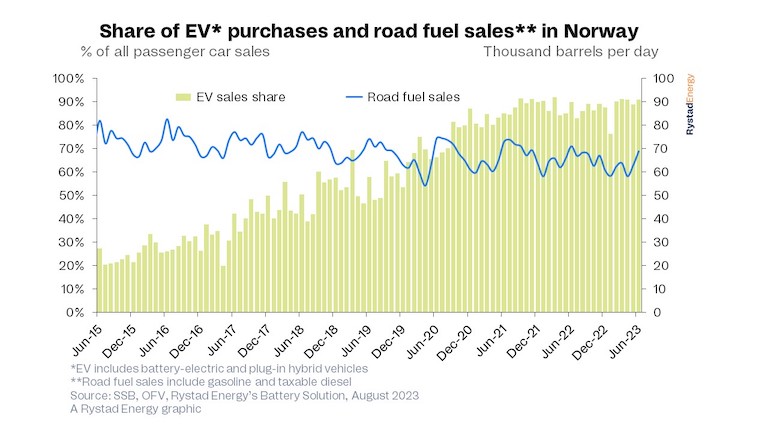Road fuel demand in Norway has remained relatively stable even with soaring electric vehicle (EV) adoption, raising questions about whether EVs really have a material impact on diesel and gasoline sales. Rystad Energy research and modeling has, however, uncovered the truth behind the persistent sales – electrifying heavy-duty vehicles, especially trucks, is essential to lowering overall fuel consumption.
EVs are often positioned as the key to decarbonizing transportation, but the latest data from the Norwegian government suggests otherwise. Electric cars have accounted for at least 80% of all passenger vehicle sales for the past three years. EVs – including plug-in hybrid (PHEV) and battery electric vehicles (BEV) – accounted for about 90% of all new car sales in 2023. More than 50% of passenger cars on the road in Oslo are electric, a threshold that BEVs alone will pass 50% in the next two years.
Such an aggressive growth in EV sales should lead to a dramatic fall in fuel demand. But that is yet to materialize, and sales figures from Statistics Norway (SSB) show diesel and gasoline demand has declined only modestly since 2017. In the first half of 2023, road fuel sales hovered around 62,000 barrels per day (bpd), a 10% fall from the 70,000 bpd sold between 2017 and 2019, well after the EV boom started. Current consumption is relatively stable between 60,000 and 70,000 bpd, and a precipitous drop is not forecast in the near term.
Our research – which goes beyond the numbers reported by SSB – tells a different story. Our model considers the official fuel sales, annual average mileage by vehicle type and car sales as reported by SSB. It converts this raw data into estimated diesel and gasoline demand, factoring in the efficiency of individual vehicles as of 2022. The upshot of this is a crystal-clear image that road fuel demand from passenger cars has declined rapidly since 2016, falling more than 20%, in line with the BEV market penetration.
Meanwhile, fuel demand from buses and trucks – which run predominantly on diesel – has grown, rising from about 30,000 bpd between 2010 to 2015 to 32,000 in 2022. A structural decline in fuel demand is not likely in the short term until the recently initiated electrification of these sectors takes hold. As a frontrunner in the transport electrification process, these findings pose significant questions for other countries trying to follow Norway’s lead.
“Electrifying the road transportation sector is a pillar of many countries’ energy transition strategy, with policymakers around the world offering incentives to those who switch to EVs. However, the situation seen in Norway could play out on a global scale as adoption ramps up. If efforts to lower emissions and reduce the carbon intensity of road transportation are to succeed, the focus should not be solely on passenger cars, but must also address heavy-duty vehicles that run on traditional fossil fuels,” says Artem Abramov, head of clean tech research at Rystad Energy.

Mileage Matters
The lackluster fuel demand destruction in Norway opens the door to a theory that BEVs do not have as significant an impact on fuel displacement as once thought or that BEV owners drive fewer miles on average. SSB reports high-quality, survey-based data on average annual mileage by vehicle and fuel type, so those myths can be dispelled.
Since 2018, the average BEV in Norway has driven more miles than passenger cars of any other fuel type. In 2022, the average BEV drove 12,950 kilometers (km), surpassing for the first time the average distance of 12,000 km for diesel passenger vehicles. Overall, average passenger vehicle travel has steadily declined in Norway, from about 13,800 km in 2007 to 11,100 km in 2022.
Average BEV distance gradually increased from around 11,800 km in 2015 to 12,950 km. EV penetration in Norway is slightly skewed towards customers and counties with above-average annual driving requirements, and charging infrastructure and vehicle range are no longer limiting factors.
Population Growth
In addition to rising fuel demand from trucks and buses, a growing population and increasing reliance on passenger vehicles are also factors behind the resilient consumption trend. The Norwegian driving-age population – people over 20 years old – has grown by 800,000 since 2005, and the number of passenger cars has increased from 0.65 to 0.75 per person over the same period. This means that the average Norwegian is more likely to own a car, resulting in total fuel sales being stretched over a larger number of vehicles.
Only in the past five years has the average mileage of non-BEV passenger cars started to taper off as battery electric cars achieve more market penetration. The BEV market is now sufficient to offset the population growth and the increase in vehicles per capita, leading to a fall in average non-BEV mileage. Total mileage for diesel, gas and PHEVs has dropped almost 20% since 2017, from around 33.7 billion km to 27.3 billion km in 2022.
On the other hand, the importance of heavy-duty non-passenger road transport has risen across the country, and electrification has been slow. Battery-electric buses only comprised 7.6% of all bus mileage in Norway in 2022, whereas the electric contribution for light/medium and heavy commercial vehicles was 2.8% and 0.2%, respectively. Therefore, the natural conclusion is that the resiliency of diesel consumption in the bus and truck sectors conceals the significant fuel demand destruction, which has happened in the passenger car segment in recent years.
Our modeling sheds light on that trend and uncovers the rapid fall in passenger car fuel demand that the official figures hide. The structural decline in road fuel demand has begun in Norway as BEV adoption accelerates and electric cars become the status quo. But the speed at which demand falls off will depend almost solely on the rate of BEV penetration in the bus and truck segment. If the transition of these sectors picks up pace, road fuel demand destruction could snowball from 2025 onward.



Follow us on social media: